
That first business plan you developed probably had lots of holes and unexpected changes, especially with how a facility was designed to function and expenses for such.
Even the savviest owner can have trouble determining a plan going forward, especially after a tumultuous past 18 months.
“A year and a half ago, everything shifted to cans. And we were, luckily, a canning brewery at the time,” said Ecliptic Brewing owner John Harris “We saw some pretty good, rapid growth as far as the can number last year. We realized it was definitely a COVID bubble in the sense that it was sales where people are buying their cases or a six-pack.
“Now bars are back open, and buying habits have changed from the off-premise back to the on-premise.”
With the pandemic still looming, speculating how to grow Ecliptic’s newest site, “The Moon Room,” has been a challenge.
“It’s really hard,” Harris said. “We ran different projected scenarios, and the best path was to find an existing plant that would give us that little step to grow, versus buying and building a brand new location. So we look forward to what’s after this.”
Ecliptic signed a five-year lease for the former Base Camp Brewing space earlier this year. Ecliptic will be both brewing and packaging in the new facility to expand beer production for new and existing brands. The new location is well set up for making Lagers, so Ecliptic will focus on the production of its new Limited Release Series beer, Pyxis Pilsner, although any of Ecliptic’s offerings may be brewed at the site as well.
“A lot of the bigger, or more regional breweries — the first and second wave — have lost their market share and a lot of capacity,” said Harris, who opened Ecliptic in 2013 and has grown to around 23,000 barrels per year of production. “I really just didn’t want to take on and build that $10-15 million brewery. I’ve been kind of looking around for an intermediate step where we could get some incremental capacity but not have to incur the expense of building a brand new brewery, at least not now. We kind of lucked into this other location.
“I think we have bought ourselves at least a year to see what happens. This allows us to go full steam ahead with that in all markets and it allows us to open up the Boise, Idaho market, which we’re not in right now. We believe that the current projections say that it makes sense that we move forward in this project.”
The biggest thing Mark Stutrud has learned through the years is that it’s extremely important to have the right people in the right positions of responsibility when pushing forward.
“It took me almost 32 years to put together the best leadership team this company has ever had, and also to focus on assets as opposed to what the hell competitors are doing,” the founder and President for Summit told Brewer. “Consequently, we have not distracted ourselves with one-off styles or what I would consider experimental styles that do not have a lot of R&D depth. We’re really concentrated on our core products that sell well and that are working for us. It’s much more important to look at your own assets, focus on those and really expand those assets so that people throughout the company are empowered individually so that everyone makes a difference in driving the business forward.
“If there’s anything I would think about starting all over it would be that,”
Stutrud said when it comes to designing a new business plan for facility growth you have to capture the mindset of being a startup all over again.
“It’s a different mindset,” he said. “You’re not preoccupied with survival, but you are preoccupied with growing when you step up your facility.“
Summit was at its first location for 12 years, and it was all leased space. When they moved into the existing location, they built it from the ground up.
“We then had a mortgage and a high level of debt,” Stutrud said when it came to managing expenses. “So, it’s important to really anticipate your cash flow and consider your sales levels to maintain profitability and to service new obligations.”
When the brewery went through a major expansion 16 years later and doubled its footprint in terms of property and capacity, another investment was needed with a new canning line.
“We had to calculate and plan into our business plan our projections and our anticipations of growth,” Stutrud said.
A few pointers that Harris shared included, to be honest with expectations after opening.
“I knew that I wanted to start as a brewpub but slowly we started shipping kegs,” he said, so seeing that growth they started to pivot toward distribution more. “I knew that I would want to have room for the brewery to grow into. So it’s important to me — at least — to find at least a 10,000 square foot building. That was my minimum. And then we took 3,000 of that and turned it into a restaurant.“
But the way Ecliptic laid out the space is not at all how Harris would have laid it out if he knew production was the endgame.
“If I had known that we’re gonna be at 25,000 barrels I would have put certain things in different places,” he admits. “But it was all about, let’s put some tanks right there. Well, I’d already built the floor out in our original area, and plus we built it out so that we had another place where we could put about six tanks. They already had the floor drain ready to go.”
But also be true to yourself, he said. Know what you want to be.
“If you really want to be a brewpub that sells 10 or 20 kegs a week, or a month, or whatever out their door? Or do you want to be a production brewery? Now those are two different games.”
Planning proper cooperage and packaging is vital for growth. Planning four to five kegs per tap handle, knowing how much an entire truck of cans costs and how fast you can deplete that stock is paramount.
“A truck worth of cans … is 8,500 cases worth of cans on a truck,” Harris points out. “If your projection is to sell 200 cases a month that truck will last a long time. You just don’t go from zero to 1,000 cases a week or something like that. It takes a while to build that up.
“That’s a real scenario, especially for startup breweries. I think that you’ve got to make sure you have that supply chain, you need to actually execute your business plan. And lots of time those people won’t talk to you until you’re in business, so it’s really a double-edged sword.”
Photo courtesy Summit Brewing






Be the first to comment